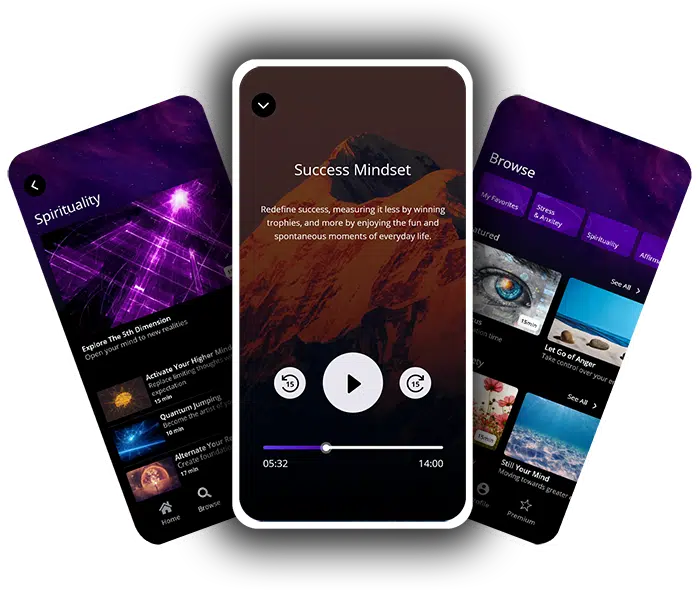Feeling stressed or anxious can weigh heavily on your mind and body. A simple, yet effective tool to manage this is deep breathing exercises. This article will guide you through 10 powerful techniques to help you find calm and reduce anxiety..
Let’s breathe stress away together.

Unleash Your True Potential!
Explore the world of meditation with our powerful guided sessions crafted to bring peace and strength to your spirit.
But first, let’s ensure our sessions are the perfect fit for you.
Take our short quiz to find out!
Table of contents
The Importance of Deep Breathing for Stress and Anxiety Relief
Deep breathing acts like a remote control to calm the mind and body, turning off the stress response. It sends a powerful message: relax. Every deep breath helps to lower heartbeat and blood pressure, making you feel less anxious and more at peace.
Imagine your lungs as balloons — filling them fully expands your chest and abdomen, signaling your nervous system that it’s time to unwind.
Harnessing the power of breath can transform moments of panic into periods of serenity. Techniques such as diaphragmatic breathing involve focusing on the rise and fall of your belly, not just moving air in and out.
This kind of mindful respiration interrupts the cycle of stress breathing exercise that keeps anxiety levels high. Whether you’re facing severe anxiety or everyday stressors, integrating deep breathing into your routine is a simple yet effective tool for fostering relaxation and improving mental health.
10 Best Deep Breathing Exercises
Explore these powerful techniques for stress and anxiety relief that include Pursed Lip Breathing, Diaphragmatic Breathing, Breath Focus, Lion’s Breath, Alternate Nostril Breathing, Equal Breathing, Resonant or Coherent Breathing, Sitali Breath, Deep Breathing and Humming Bee Breath (Bhramari) to foster a sense of calm and relaxation.
Mastering these exercises can have immense benefits on your overall well-being and can be seamlessly incorporated into your daily routine.
Pursed Lip Breathing
Pursed lip breathing stands out as a game-changer for easing stress and anxiety. It’s all about inhaling through the nose, then exhaling slowly through lips that are pressed together, almost like blowing out a candle.
This method shifts your focus to each breath, making every inhalation and exhalation deliberate and slow. It not only helps in managing stress levels but also makes sure you’re getting the most out of your oxygen intake.
For anyone on a journey toward personal growth or delving deeper into spiritual practices, this technique is foundational. By controlling ventilation and oxygenation efficiently, pursed lip breathing allows for a calmness that can anchor you during turbulent times.
Making it part of your daily routine could enhance meditation sessions, improve focus during yoga breathing exercises, and support overall healthier living. Plus, its simplicity means you can practice anywhere—no special tools needed except your willingness to breathe mindfully.

Unleash Your True Potential!
Explore the world of meditation with our powerful guided sessions crafted to bring peace and strength to your spirit.
But first, let’s ensure our sessions are the perfect fit for you.
Take our short quiz to find out!
Diaphragmatic Breathing
Shifting from the gentle flow of pursed lip breathing, let’s dive into the power of diaphragmatic breathing. This technique focuses on strengthening your diaphragm, ensuring a fuller and more efficient lung capacity.
Imagine drawing air deep into your belly rather than just the top of your lungs. It’s about turning every breath into a calmer, more centered moment—perfect for anyone diving deeper into their spiritual journey or seeking personal growth.
Studies highlight its effectiveness in reducing stress hormones and enhancing attention, making it an essential tool for managing anxiety. By encouraging full oxygen exchange, you not only reduce stress but also boost lung efficiency—a win-win for overall health.
So next time you feel overwhelmed, remember: a deep belly breath can be your first step to tranquility.
Breath Focus Technique
The Breath Focus Technique involves bringing awareness to your breath without trying to change it, done while sitting or lying down in a comfortable place. This technique is associated with the 10 best deep breathing exercises for relief from stress and anxiety.
Scientific studies have shown that controlling your breath can help manage stress and stress-related conditions. There are expert-backed breathing exercises that can provide relief during times of high stress or anxiety.
Breathing exercises for stress, anxiety, and panic can take just a few minutes and can be done anywhere.
Lion’s Breath
Now, moving from the soothing techniques of Breath Focus, let’s venture into Lion’s breath. This yogic practice known as simha pranayama involves inhaling through the nose and then exhaling forcefully while sticking out your tongue and making a roaring sound.
It has been said to release tension in the chest and face areas, providing a light-hearted and energizing way to loosen up during yoga sessions.
Simha pranayama is not just another breathing exercise – it’s an opportunity for fun and playfulness within your practice. Incorporating Lion’s Pose can infuse your routine with a sense of lightness that helps you connect more deeply with yourself..
Alternate Nostril Breathing
Alternate nostril breathing, also known as nadi shodhana, is a yogic breathing technique believed to reduce anxiety and enhance meditation. This method involves controlling the breath with focused attention, which has been linked to improving cardiovascular function and lowering heart rate.
It’s a simple yet effective way to alleviate stress and anxiety, making it particularly beneficial for those seeking spiritual growth and mindfulness practices.
By incorporating alternate nostril breathing into your routine, you can experience the calming benefits of this ancient practice, aligning your mind and body for a more centered approach to daily life.
Equal Breathing
Now, let’s shift to another effective deep breathing technique known as Equal Breathing. This breathing technique involves inhaling and exhaling for an equal count. It helps in calming the nervous system, reducing stress and anxiety, while also enhancing concentration and focus.
One of its remarkable aspects is its portability and accessibility because it can be practiced anywhere at any time.
Equal Breathing provides a simple yet powerful method for managing stress and anxiety of everyday life with tangible benefits backed by academic research.
Resonant or Coherent Breathing
Resonant or coherent breathing is technique that reduces anxiety and induces relaxation. Breathing at a rate of five breaths per minute, with equal inhalation and exhalation, helps lower stress levels and promotes mindfulness.
It’s versatile, can be practiced lying down or standing up, and recommended for improving sleep, stress, recovery, and overall well-being. This type of breathing exercise relaxes both the mind and body; it improves breathing while promoting a sense of calmness.
Practicing resonance breathing lowers stress levels and enhances mindfulness. It’s considered one of the best techniques for reducing anxiety because it induces relaxation in both the mind and body.
Sitali Breath
Transitioning from resonant or coherent breathing, let’s explore Sitali Breath. This yoga technique involves drawing air across the tongue to create a cooling effect, making it beneficial for anxiety and stress relief.
As part of your journey into deep breathing exercises for personal growth and meditation, Sitali Pranayama is a valuable addition due to its ability to cool the body using controlled breathing techniques.
Deep Breathing
Moving from Sitali Breath to Deep Breathing, it’s essential to understand that deep breathing lies at the core of many techniques for stress and anxiety relief. Utilizing expert-backed breathing exercises can provide immense relief during high-stress or anxious times.
Simple deep breathing exercises help relieve stress and reduce anxiety, offering a convenient way to find peace anywhere you are. The technique is widely recognized for promoting relaxation, improving breathing patterns, and enhancing overall well-being.
Deep breathing plays a pivotal role in reducing the effects of stress and anxiety. It offers an effective means to calm the mind and body while promoting mental clarity and emotional balance.
Humming Bee Breath (Bhramari)
Bhramari Pranayama, also known as Humming Bee Breath, is a powerful technique to calm the mind and relieve stress and anxiety. By making a humming sound during exhalation, it downregulates the nervous system and increases heart rate variability.
This slow-paced breathing practice has been associated with spiritual benefits while also impacting overall health positively. Evidence indicates that relaxation techniques like Bhramari Pranayama can boost heart rate variability, making it an effective tool for managing stress and promoting well-being.
Practice of this breathing exercise can prevent anger, instantaneously create a sense of calm around the forehead, and provide relief from agitation, frustration, and anxiety. The hum created during exhalation in Bhramari Pranayama not only promotes mental tranquility but also has numerous positive effects on physical health.
Conclusion
Mastering deep breathing exercises can bring peace and relief from stress and anxiety. These techniques, like pursed lip breathing and diaphragmatic breathing, offer a powerful tool for calming the mind.
Lion’s breath, alternate nostril breathing, and equal breathing are also effective ways to regain control over your emotions. Set aside time each day to practice these exercises; embrace the tranquility they bring into your life.
FAQs
What are deep breathing exercises?
Deep breathing exercises are techniques that help you take slow, deep breaths. They can calm your mind, lowers stress, and improve health problems like high blood pressure and asthma.
How does belly breathing help with stress?
Belly or abdominal breathing activates the parasympathetic nervous system. This slows down your heart rate and lowers blood pressure, creating a feeling of calm and reducing stress.
Can deep breathing exercises assist people with asthma or COPD?
Yes, for those with asthma or chronic obstructive pulmonary disease (COPD), certain exercises like pursed-lip breathing can make it easier to breathe by opening airways and improving lung function.
Are there any deep breathing techniques for panic attacks?
Absolutely! Techniques like rhythmic breathing help control panic attacks by focusing on even breaths in and out, which can prevent shortness of breath and lower anxiety levels.
Do I need any special tools or apps for these exercises?
Not really! While there are apps available on Google Play Stores that guide you through various techniques, all you truly need is a quiet space where you can breathe deeply without distractions.
How often should I practice these deep breathing exercises for them to be effective?
Practicing daily is key — even just a few minutes every day can contribute to better health outcomes over time, including reduced anxiety levels and improved overall wellness.










